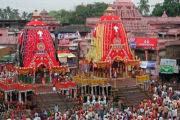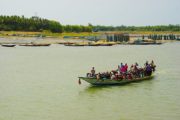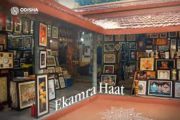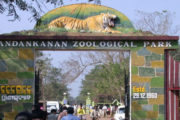| DEPARTURE/RETURN LOCATION | Bhubaneswar Airport / Railway Station
Bhubaneswar Airport / Railway Station |
||
| DEPARTURE TIME | Please arrive at least 2 hours before the flight / Train. | ||
| INCLUDED |
|
||
| NOT INCLUDED |
|
Day 01‐ Bhubaneswar
Upon arrival at Bhubaneswar Airport/ Railway Station Transfer to hotel. Bhubaneswar Known as the “Temple City”,founded during the Kalinga empire over 3,000 years ago, Bhubaneswar today boasts of a cluster of magnificent temples, which once boasted of more than 2000 temples. still preserves over 500 of India’s finest temples. If time permits visit Lingaraj Temple Constructed in 650 A.D. this temple is a unique specimen of Oriyan style of architecture. The most special feature of this temple is the presence of one thousand lingas in the north-west corner of the complex.. Dedicated to Lord Shiva as the name suggests, the temple was built sometime in the 7th century by the King Jajati Keshari. The Lingraj Temple houses a Shivalingam that rises to a massive height of 8 inches above the floor level and is about 8 feet in diameter as well. Lingaraj Temple is a spectacular specimen of Orissa style of temples with a hint of Kalinga style of architecture, covering a vast area of 2,50,000 sq ft., stand tall 180 ft.As many as 150 smaller shrines dot the temple complex. Non Hindus are not allowed inside the temple. Then visit Rajarani temple A popular 11th-century the Raja Rani Temple is locally known as the ‘love temple’ because it contains some sensuous carvings of women and couples. No images can be found inside. the sanctum, and hence the temple is not associated with any particular sect of Hinduism.
This is perhaps exactly where the charm of the temple comes from: the temple belongs to no specific sect and is open to all people irrespective of the deity that they worship and admire. However, the figures of Lord Shiva and Goddess Parvati carved on the walls strongly indicate that the temple has certain associations with Shaivism. Brahmeshwar Temple was built during 11th century A.D in honor of the presiding deity Brahmeshwar, who is a form of Lord Shiva. The 60-feet tall temple .was the first to exhibit iron beams in construction and splendid iconography of dancers and musicians on the walls. The porch features carved ceiling with lotus, while the walls have motifs of lion head in abundance. Mukteshwar Temple is one of the most compact and smallest temples in Bhubaneswar, but is renowned for its imposing ceiling that is adorned with eight-petal lotus in the porch, and astounding stone archway. It was for the first time that carved images appeared in temple architecture, exhibiting beautiful lion-head motifs. “Mukteshwar” means “Lord who gives freedom through Yoga.” Parshurameswar temple The small but luxuriantly designed temple was built during 7th century and is one of the oldest in Bhubaneswar. The temple exhibits marvelous
architectural artwork. Afte lunch visit khandagiri and Udaygiri caves and explore the age-old caves of Khandagiri and Udaygiri, carved by jain Monks in the 1st century BC, and were usssed as dwellings aaand meditation quarters, were built under King Khaarvela of the Mahameghavahan dynasty. Overnight at hotel.
Day 2 – Bhubaneswar
After breakfast visit state museum, are housed archaeological objects, art and craft objects, natural history objects, Bronze Age tools and stone sculptures also contains bronze images, traditional and folk musical instruments, coins, copper plates, prehistoric objects, ethnological objects and armoury. Also its huge collection of manuscripts on palm-leaves,
tourists can view palm leaf manuscript of 12th century devotional poem Gita Govinda. By a collection of traditional and folk musical instruments and sculptures of different shapes and sizes, the museum expresses the vivid history and cultural traditions of Orissa. Collections of the museum also include copper plates, coins, stone inscriptions, manuscripts written on the
palm leaves and age-old bronze tools. At the museum, tourists can also get an insight into rare epigraphic records stored in Epigraphy Gallery, handicraft, small paintings, collection of patta paintings, brassware, stone sculptures.
Tribal Museum, known as Orissa Museum of Tribal Art and Artifacts, provides a detailed information about the tribal life and culture of Orissa. It reveal about more than sixty varied tribal groups of Orissa, their way of living, handicrafts, musical instruments, songs, dances
and festivals.The Tribal Museum has a rich collection of stone and wood sculptures, metal objects and images, weapons, wooden objects, anthropological objects, jewelry, textiles, terracotta, tribal dresses and also some remarkable records, which have been conserved
about these tribes. The museum also exhibits the huts of the tribes. Visit Nandan kanan zoo. Nandankanan Zoological Park is a 400-hectare zoo and botanical garden in Bhubaneswar, The name Nandan Kanan refers to garden of pleasure. Nandan Kanan is a combination of zoo, sanctuary and botanical garden. It is located 20 kms from Bhubaneswar amidst the splendid surroundings of the Chandaka Forest You will also get to see several endangered species that are well protected within the wildlife sanctuary and zoo of Nandan Kanan. These species consist of three categories of Indian Crocodiles, Lion tailed Macaque, Asiatic Lion, Nilgiri Langur, Mouse Deer and Indian Pangolin. There are numerous species of birds (81), fishes as well as reptiles. You can go on safaris to the Nandan Kanan Wildlife Sanctuary to see these rare white tigers, and some majestic Asiatic lions who roam freely in their natural habitats. You can enjoy rope way and boat riding facilities in lake also. Evening Viist Ekamra haat situated in the heart of Bhubaneswar. It is a popular place for purchasing handicraft and handlooms products. It has 42 handlooms and handicraft shops and 8 open display corners which provide consumers with natural and original artisan products.You can find craft and textile products of artisans from different parts of the state.The shops in Ekamra Haat displays various crafts like stone carving work, wood carving work,applique, pattachitra,cane & bamboo work, dhokra,bell metal,terracotta work,palm leaf engraving,and art textiles such as Bandha sarees from Sambalpur & Nuapatana. Overnight at Hotel.
Day 3- Bhubaneswar – Bhitarkanika ( 168 Km/4 Hrs)
The Bhitarkanika Mangrove Forest (made of Oriya words bhitar, meaning interior and kanika, meaning exceptionally beautiful) is the world’s largest and most relevant nesting ground for the endangered Olive Ridley Turtles. Every year, nearly a million Olive Ridley Turtles lay over 84 million eggs on the Gahirmatha Beach, which lies along the Bhitarnika Mangrove Forest, inside the Gahirmatha National Park. Bhitarkanika Mangrove
Forest is a natural and wildlife reserve that is home to over 55 species of mangroves, 170 species of birds and a large population of saltwater crocodiles, hawksbill and leatherback turtles, endangered king cobra and the Indian rock python covering aa areaof 672 square
kilometre national park.This mangrove forest in India is also a dream come true for birdwatchers as migratory and resident birds such as Asian Openbills, six species of
kingfisher, five species of egrets and the black-headed ibis can be spotted. Overnight at Hotel.
Day 4- Bhitarkanika – Ratnagiri/ Lalitgiri/ Udaygiri- Bhubaneswar (168 Km/ 4 Hrs )
Day 5- Bhubaneswar – Konark- Puri. ( 108 Km/3 Hrs)
Revered by Buddhists as the place where ancient Indian emperor Ashoka renounced violence and embraced Buddhism, the site pagoda , and see two of the rock-carved edicts declaring Ashoka’s new religious principles that date from 260 BC. Then view some rock-cut caves, medieval Hindu temples, and the renovated Shiva temple near Pagoda. Continue to vsisit Pipli the artist village where locals produce appliqué art- a process of cutting coloured cloth into shapes of animals, birds, flowers, leaves , gods, goddesses and other decorative motifs and stiching them over a piece of cloth. These creations are fabricated into lampshades, handbags, cushion covers, or even garden umbrellas. Later visit Konark the Chariot of the Sun God temple, built by Laqngula Narasingh Deva in 13 th century A.D.. The Sun temple is known for its exquisite and intricate architecture and sculptures. An UNSECO World Heritge List of monument. The word ‘Konark’ is a combination of two words ‘Kona’ and ‘Arka’. ‘Kona’ means ‘Corner’ and ‘Arka’ means ‘Sun’, so when combines it becomes ‘Sun of the Corner’, dedicated to Sun God. Konark is also known as Arka khetra. There are three different sides of the temple, positioned in proper direction to catch the rays of the sun at morning, noon and evening.King Narasimhadeva the great ruler of the Ganga dynasty had built this temple, with the help of 1200 artisans within a period of 12 years (1243-1255 A.D.). Konark Temple was designed in the form of a gorgeously decorated chariot mounted on 24 wheels , each about 10 feet in diameter, and drawn by 7 mighty horses. It is really difficult to understand, how this huge temple, every inch-space of which was so wonderfully carved, could have been completed within such a short time. Whatever that might be, the konark temple even in its present ruined state, still a wonder to the whole world. Great poet Rabindranath Tagore wrote of Konark: “here the slanguage of stone surpasses the language of man.”
Drive through marine drive to Puri, on the way visit Chandrabhaga beach, Ramachandi temple. Evening free at beach for relaxation. Overnight at Hotel.
Day 6 - Puri - Satpada - Puri. (48 Km/ 1 Hrs)
basis) Enjoy the day at chilka lake (India’s biggest inland lake spread over 1,100 square kilometers) Boating at the lake to spot the wild Asiatic Irrawaddy Dolphins at the mouth of the Bay of Bengal . Overnight at Hotel..
Day 07 –Departure to Bhubaneswar/ Puri
Railway Station or Puri Railway Station. for onward Journey.









